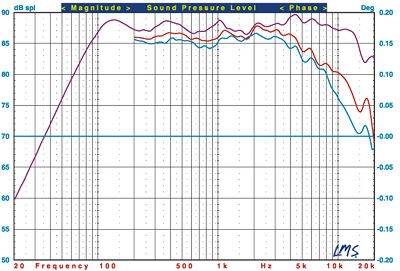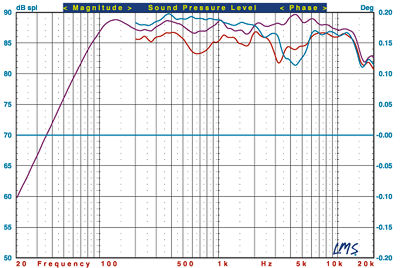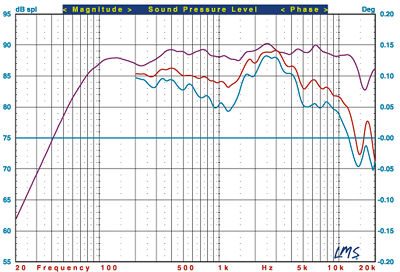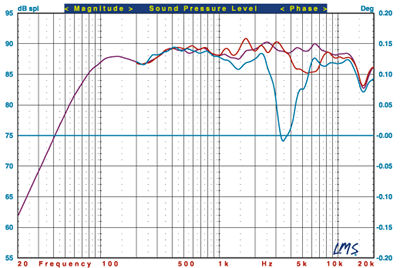JBL Performance surround speaker system Measurements
The JBL PT800BE's sensitivity measured approximately 88dB/W/m, and its sealed cabinet is tuned to approximately 64Hz. I rate its nominal impedance at about 6ohms, and its minimum impedance is 4.2ohms at 154Hz—the speaker should be a relatively easy load to drive.
Fig.1 (violet) shows the PT800BE's pseudo-anechoic response at tweeter height, averaged over a 30° forward horizontal angle and combined with the nearfield responses of the woofer. The useful bass extends down to about 56Hz (-10dB relative to the output at 150Hz). The on-axis average is very smooth, with a slight emphasis in the mid-treble from about 4 to 8kHz. Off-axis, the high-frequency response rolls off smoothly with increasing frequency, as it should.

Fig. 1
Fig.2 again shows the PT800BE's averaged horizontal front response (violet), plus the vertical responses taken at +15° (red) and -15° (blue) relative to the tweeter. The responses are well-matched, though the off-axis dips in the low treble suggest that, for the best response, you should not sit with your ears located very far above or below the tweeter.

Fig. 2
The JBL PC600BE center-channel's cabinet is tuned to about 70Hz. I'd rate its nominal impedance at 6ohms, and its minimum impedance is 4.7ohms at 172Hz (with another minimum of 4ohms at 3.2kHz). The speaker's sensitivity measured approximately 88dB/W/m; the PC600BE, too, should be relatively easy to drive.
The PC600BE's measured front horizontal response, taken on the tweeter axis and averaged in the same manner as described above for the PT800BE, is shown in Fig.3 (violet). The useful bass extended down to about 49Hz (-10dB relative to the output at 150Hz). The on-axis response is very smooth, but off-axis, the response is less linear than I expected from a 3-way design. A significant peak that develops at about 2.5kHz might actually enhance vocal intelligibility (the dips typical of 2-way center-channel speakers usually degrade it), but at the expense of accuracy.

Fig. 3
The PC600BE's ±15° vertical off-axis performance (Fig.4) is good, though the dip at -15° suggests that, if the speaker is mounted above a big-screen TV, it should be tilted down toward the listeners.—TJN

Fig. 4





























































